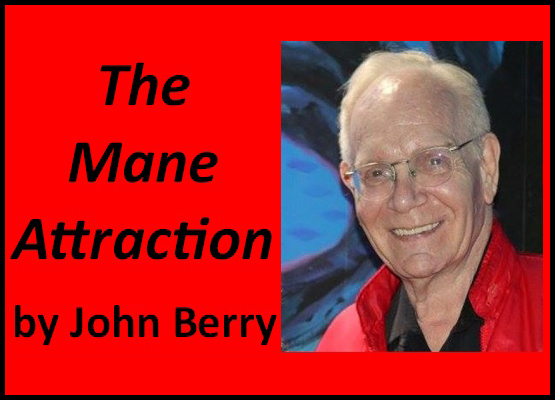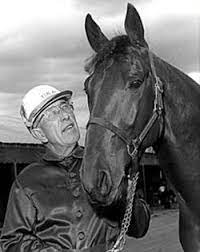In these uncertain times in the world, it’s important to lighten up once in a while with a bit of harness racing history and levity going back sixty-plus years.
After all, with a hurricane at our door, global warming, wars and threats bringing unrest to many parts of the world, our problems in harness racing seem trite to the vast majority.
 And our electricity is back on!
And our electricity is back on!
So, I’ll start with a memory from my first “real” trip to the racetrack, which, by the way, started in a Chicago bowling alley—Bryn Mawr Bowl.
I had just turned 16 at the time and was a pretty decent bowler.
They had these pot games where we’d all put up $2 or $5 with winner take all.
I, of course, was one of the youngest of all the pot-game bowlers—if not THE youngest—in the group consisting, this day, of the beer-drinking Tom Slattery, the old-timer Charlie Clay and the guy with the white speckled bowling ball, Jim Moraetes, and the REAL old-timer, Frank Brown among several others.
They were all a lot older than I with Frank, probably in his 60’s, the oldest and all of the others in their 30’s and up. They’re all gone now…but, for me, their memories live on.
One of the guys—“Slats”—shot over 750 for the three game series…and I beat him! Yes, I beat them all!! 248-268-258—774!
So, I won around $15, which was a lot of money for a 16-year-old to have in his pocket back in 1959.
One gentleman, Luke, came down and offered me some money and I said that I had already won some and he retorted that they had won a few hundred betting on me in the back.
I had become friends with Luke many moons before and many other of the “degenerates” like Zaza and The Barber and Rico and Leo who came to watch the pot games.
(I guess I was somewhat of a “ringer” back in those days.)
Anyhow, I refused his offer for cash, and he insisted that he take me out for a snack.
I envisioned The Patio restaurant across the street from the bowling alley but, instead, Luke had other ideas, since he had not missed one single night of harness racing in the Chicago area since Sportsman’s Park opened back in 1949.
Luke knew everyone at the track. He had a Box there—41-A—and rubbed shoulders with all the great ones—from the Pletchers to the Grahams…from Gene Riegle to Lou Rapone…from Jim Dennis to Bobby Williams…Billy Shuter to Jack Hankins…
Luke knew ‘em all…
This particular night, there was a big Stakes race—The American-National—and Luke said that there were two races he wanted to bet—that one and the next one after that.
Senator Frost was the first one and he won the big race for Dick Buxton and a guy by the name of John Peat won the last one.
You probably haven’t heard of John Peat—he’s all but forgotten today—but he was the trainer of a Potomac Lad trotter out of the mare Spud’s Sue.
He had raced a few times as a two-year-old at the Illinois fairs but didn’t race at three.
So, here he was as a four-year-old and Luke heard that some bigwigs might be after him.
The horse won the last race of the night at Sportsman’s Park in, I believe, 2:02, which was very, very fast for that era.
Those 10 races on August 22, 1959, were enough to hook me on harness racing.
By the way, the horse’s name was Su Mac Lad, who went on to wear out several sets of Free-For-All trotters during his gallantly long career while earning over $880,000.

Dancer made the purchase for Irving Berkemeyer who made the deal after that race with the price being $35,000.
Dick Baker, Stanley Dancer’s right-hand man and, sadly, all but forgotten today, was sent to pick up a hearse for Berkemeyer’s business and then go over to the track to take a look at the horse.
When Baker drove the hearse through the stable gate, everyone thought someone had died—but Baker was there for the moment that may change the future of and for a “kind of” nondescript four-year-old trotting gelding that might have some big potential…and it did.
He took Su Mac Lad for a “spin,” as he called it, and liked him.
Dick Baker and I spent many a winter afternoon—no matter how cold—after the races at Freehold and he reminisced about everything, again, no matter how cold.
“I told Stanley that I liked him a lot and he should pay the price,” Baker said.
“After he made his first start, his wife said that he got a $35,000 lemon…but that sure turned into gallons and gallons of lemonade….and he did it the hard way because he was always starting from the outside posts…so he earned every single dime!”
So, after that first “real” trip to the races, the standardbred was laced in my blood and, rain or shine and, many times, on sub-freezing double-header days or nights, I’d be in the stands—that is, when I wasn’t in the bowling alley!
One of those days was March 17, 1962, at Maywood Park when winter was in a war with spring.
The temperature hovered a degree or two above or below freezing with rain, sleet and snow taking turns making the half mile oval almost impossible to negotiate…almost!
It was that day that I witnessed a world record that will never be broken…ever.
A three-year-old colt named Scotsdam, driven by Ken Lighthill paced a winning mile in 3:38 3/5—the slowest winning pari-mutuel mile in history.
As one might imagine, the track was a quagmire, probably a foot-and-a-half deep, but it sure was enjoyable to witness.
A couple of nights later, a horse by the name of Great Northern won in 3:35 3/5—last QUARTER 1:03 with Bob Farrington in his sulky.
Bob told me that, once he got Great Northern back to his stall, he laid down for three days…”and didn’t even get up to ‘empty out!’”
In September of that year, Washington Park, the famed thoroughbred track, opened for harness racing and over 30,000 fans packed the place—and I was proudly one of them.
They had the longest stretch in harness racing—1,320 feet—and became an iconic track until it burned to the ground in 1976.

The year 1964 was especially memorable at Sportsman’s Park as the two-year-old pacer Bret Hanover set the track record in 2:01.1…quite something back then. (And to think that today, some are close to 60 lengths faster than that.)
One of the greatest New Zealand bred pacers were there, too, Cardigan Bay, as was Su Mac Lad.
A couple of my favorites were Pole Adios and Dusty H. Forbes—the former so highly spirited and ornery that he had to be trained to a pick-up truck and the latter checked up so low that I thought he’d scrape his nose on the track!
There were a probably thousand more I remember but this Mane Attraction is not used to going two heats, so I’ll close it with a bit of levity when I worked in the racing office as Assistant Race Secretary at The Pomp.
There was a trotter there that had as many qualifying starts as official races and the trainer, Jimmy S., came in one day after the horse qualified and said the problem was that his horses just didn’t like nighttime racing.
“Look”, he said, “if you could do me this favor, I would appreciate it if you could put him in a first race, since it will still be light, and he could finally get a win.”
We obliged and got him in the first race one night.
He zipped off the wings and cut some very reasonable fractions but, right at the 16th pole, went up in the air.
The next morning, Jimmy came into the office, and we asked what happened and he said, “well, right at the 16th pole when he broke, it was starting to get dark!”
Neither I or Race Secretary Greg DeFrank (who didn’t smile very often) could contain ourselves and the lighten was so loud that one could probably hear it at Gate 5.
There are a thousand more stories over my past 60-plus years from trainers like Jimmy S., but we’ll wrap up this heat and catch up on some others when we have room for another double heat Mane Attraction.
by John Berry, for Harnesslink

 USA
USA Canada
Canada Australia
Australia New Zealand
New Zealand Europe
Europe UK / IRE
UK / IRE


